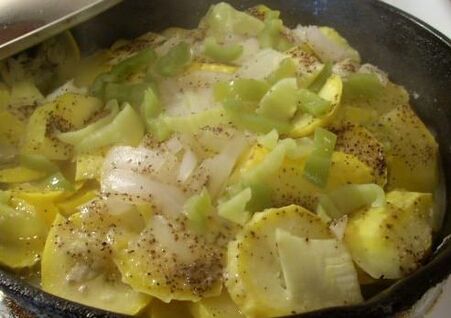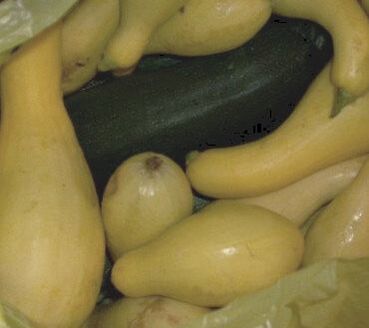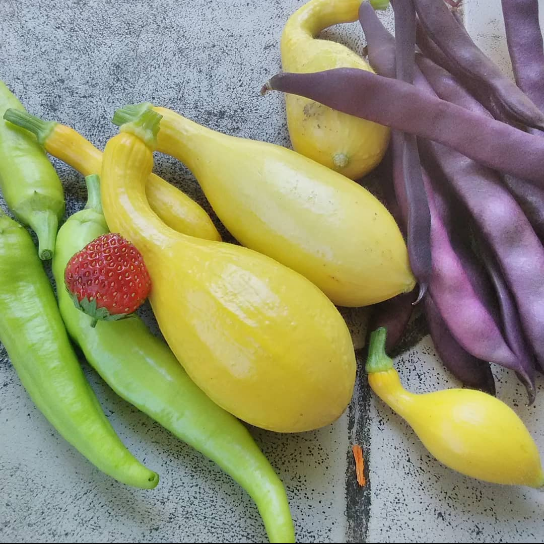Smothered Yellow Squash & Growing Yellow Summer Squash
Smothered Yellow Squash

The yellow squash is sometimes called crookneck or straightneck yellow summer squash...It is pale yellow when young and tender...and it is very good! Always wash it well and trim off any spots, scrapes or marks to be sure there isn’t grit or dirt embedded in the flesh.
I slice it up thin, about 1/4 of an inch, in a skillet with about a 1-2 T butter or olive oil on medium heat. I heap the squash to the top of the skillet. Add chopped onions, salt, pepper, and 2-3 pats of real butter on top of the squash. Cover tightly, turn it down to medium low, and let simmer until done, approx. 20-25 minutes. Watch closely that it doesn't dry out and burn. Sometimes I let it get golden brown on bottom. With a spatula pick up and look underneath, but don't stir or mix. Add a little more butter if needed around edges to help it brown. Turn it to the lowest setting and let it brown to your liking.
You can also just stir-fry it all over medium heat without covering it - but then it wouldn't be called smothered squash.😅
Variations: Use this same recipe for most vegetables such as sliced potatoes, or okra w/tomatoes and onions. Use your imagination and create a new dish your family will love!
Cooked Smothered Squash may also be used as a variation (addition) in the recipe for Squash Dressing, Cornbread, Chicken and Dressing.
I slice it up thin, about 1/4 of an inch, in a skillet with about a 1-2 T butter or olive oil on medium heat. I heap the squash to the top of the skillet. Add chopped onions, salt, pepper, and 2-3 pats of real butter on top of the squash. Cover tightly, turn it down to medium low, and let simmer until done, approx. 20-25 minutes. Watch closely that it doesn't dry out and burn. Sometimes I let it get golden brown on bottom. With a spatula pick up and look underneath, but don't stir or mix. Add a little more butter if needed around edges to help it brown. Turn it to the lowest setting and let it brown to your liking.
You can also just stir-fry it all over medium heat without covering it - but then it wouldn't be called smothered squash.😅
Variations: Use this same recipe for most vegetables such as sliced potatoes, or okra w/tomatoes and onions. Use your imagination and create a new dish your family will love!
Cooked Smothered Squash may also be used as a variation (addition) in the recipe for Squash Dressing, Cornbread, Chicken and Dressing.

As long as I can remember, my family has grown yellow summer squash. It is a basic summer requirement, to have yellow summer squash in the garden. It’s almost as important as Southern Fried Chicken. There’s nothing like fried squash, squash casserole, smothered squash, or simply adding thin slices to a salad, or using it to dip in homemade ranch dressing. Clearly it is something we love. Fresh, raw slices of young tender squash, paired with fresh homegrown tomatoes is a delicious combination.
Squash seeds should be sown directly into the ground as soon as the chance for frost has passed. Yellow summer squash are a cut and come again plant, and given the right conditions, you will be rewarded with plenty of them. But they are very much heat intolerant. They will dwindle down to nothing once it is midsummer. That’s why it is important to get them planted as early as possible, so they have plenty of time to produce before the heat gets to be too much for them. That said, they can be planted again for a fall harvest if timed right according to first frost date. Some varieties will be ready for harvest in 45 to 60 days!
They should be planted in a hill, not in a row or elsewhere, really. (The same as cucumbers.) A hill in my opinion prevents root rot, since the water drains off more easily than if they were in a hole. A hill, meaning take a hoe and pull dirt up into a small round mound, approximately two feet in diameter. Poke 3-4 holes in the mound about 6-8 inches apart. Pour water into the holes, then put two-three seeds in each hole. Cover with dirt, and press the dirt around the seeds to make sure the seeds are in contact with the dirt. In a few days the seeds will sprout.
It is also a very misunderstood vegetable in some circles. I think this is because people think it is comparable to all the other kinds of squash, and it is not. It is a delicate vegetable. First of all, you have to watch them closely when they start to grow. They should be picked when they are still pale yellow. We always want to wait and let them get larger, but there are risks in letting them stay on the plant too long. With the first hint of them turning dark yellow or orangish colored it is time to pick and cook. In fact they may be past time, in order to be at their peak of tenderness, they really should still be pale yellow. Also, It isn’t something that can be stored for any length of time. They must be used fairly quickly. I’m talking about just a few days after it is picked. If it is going to be put up in the freezer, it definitely needs to be right at its peak, or else you will end up with tough, rubbery squash when it is cooked.
I see all of these photos of yellow summer squash, that looks like dark yellow, huge zucchinis in some cases. People need to know that it needs to be picked a lot sooner than all the other squashes that are allowed to stay on the plant for longer periods of time. Secondly, if it is too large, or starting to turn darker, the seeds get hard, and sometimes bitter. At the most, it should be picked when it is no larger than about 8 inches long. You should be able to slice right through the seeds without any resistance whatsoever.
More recipes for yellow summer squash, as well as zucchini HERE.
Squash seeds should be sown directly into the ground as soon as the chance for frost has passed. Yellow summer squash are a cut and come again plant, and given the right conditions, you will be rewarded with plenty of them. But they are very much heat intolerant. They will dwindle down to nothing once it is midsummer. That’s why it is important to get them planted as early as possible, so they have plenty of time to produce before the heat gets to be too much for them. That said, they can be planted again for a fall harvest if timed right according to first frost date. Some varieties will be ready for harvest in 45 to 60 days!
They should be planted in a hill, not in a row or elsewhere, really. (The same as cucumbers.) A hill in my opinion prevents root rot, since the water drains off more easily than if they were in a hole. A hill, meaning take a hoe and pull dirt up into a small round mound, approximately two feet in diameter. Poke 3-4 holes in the mound about 6-8 inches apart. Pour water into the holes, then put two-three seeds in each hole. Cover with dirt, and press the dirt around the seeds to make sure the seeds are in contact with the dirt. In a few days the seeds will sprout.
It is also a very misunderstood vegetable in some circles. I think this is because people think it is comparable to all the other kinds of squash, and it is not. It is a delicate vegetable. First of all, you have to watch them closely when they start to grow. They should be picked when they are still pale yellow. We always want to wait and let them get larger, but there are risks in letting them stay on the plant too long. With the first hint of them turning dark yellow or orangish colored it is time to pick and cook. In fact they may be past time, in order to be at their peak of tenderness, they really should still be pale yellow. Also, It isn’t something that can be stored for any length of time. They must be used fairly quickly. I’m talking about just a few days after it is picked. If it is going to be put up in the freezer, it definitely needs to be right at its peak, or else you will end up with tough, rubbery squash when it is cooked.
I see all of these photos of yellow summer squash, that looks like dark yellow, huge zucchinis in some cases. People need to know that it needs to be picked a lot sooner than all the other squashes that are allowed to stay on the plant for longer periods of time. Secondly, if it is too large, or starting to turn darker, the seeds get hard, and sometimes bitter. At the most, it should be picked when it is no larger than about 8 inches long. You should be able to slice right through the seeds without any resistance whatsoever.
More recipes for yellow summer squash, as well as zucchini HERE.
GROWING YELLOW SUMMER SQUASH
